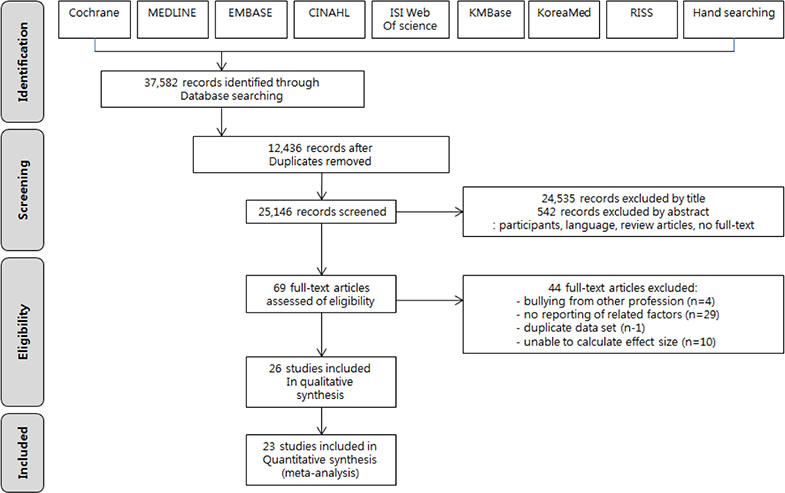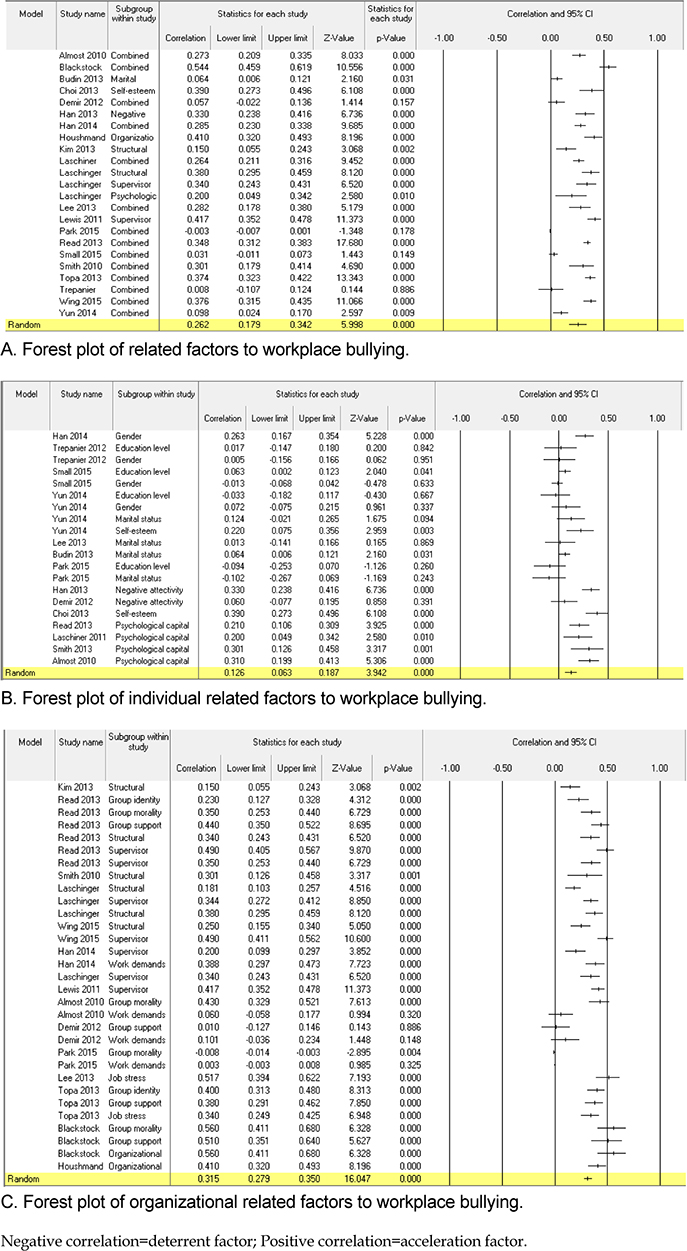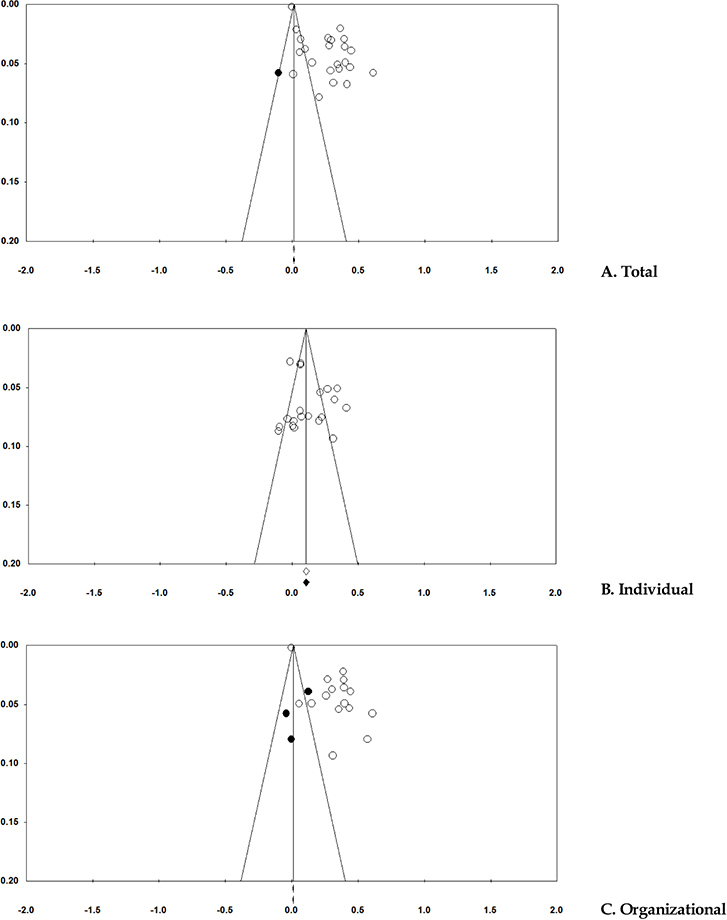Korean J Adult Nurs.
2016 Aug;28(4):399-414. 10.7475/kjan.2016.28.4.399.
The Related Factors to Workplace Bullying in Nursing: A Systematic Review and Meta-analysis
- Affiliations
-
- 1Department of Nursing, Dong-A University, Busan, Korea.
- 2Kosin University Gospel Hospital, Busan, Korea. joyfulmj80@naver.com
- KMID: 2351404
- DOI: http://doi.org/10.7475/kjan.2016.28.4.399
Abstract
- PURPOSE
The purpose of this study was to review and identify factors relevant to workplace bullying in nursing.
METHODS
Twenty-three studies that met the criteria were selected from a sample of twenty-six studies. These articles were retrieved from a central literature databases (N=13,241). The total correlational effect size (ESr) for each related factor was calculated from Fisher's Zr. A funnel plot inspection (similar to scatter plot) with a trim-and-fill method was used to assess the publication bias of the meta-analyzed studies.
RESULTS
From the systematic review, fifty-one factors were identified as having an influencing effect. Fourteen factors (five individual and nine organizational factors) were eligible for meta-analysis. The individual factors included, self-esteem (ESr=-.31), psychological capital (ESr=-.26), and marital status (ESr=-.06) which were significantly correlated with workplace bullying. Organizational factors included, organizational tolerance (ESr=.48), supervisor incivility (ESr=.47), job stress (ESr=.46), group morale (ESr=-.36), group support (ESr=-.35), supervisor leadership (ESr=-.35), group identity (ESr=-.33), and structural empowerment (ESr=-.27). These factors were significantly correlated with workplace bullying. There were no publication biases except for both individual and organizational factors.
CONCLUSION
Organizational factors have more of an greater impact than individual factors on workplace bullying. The results of this study support the need for intervention at the organizational level.
Figure
Cited by 2 articles
-
Effectiveness of Interventions for Workplace Bullying among Nurses: A Systematic Review
Sun-young Park, Hana Shin, Yeuok Cho, Sue Kim
J Korean Acad Nurs Adm. 2018;24(4):339-351. doi: 10.11111/jkana.2018.24.4.339.Response Patterns of Nursing Unit Managers regarding Workplace Bullying: A Q Methodology Approach
Jin Kyu Choi, Byoungsook Lee
J Korean Acad Nurs. 2019;49(5):562-574. doi: 10.4040/jkan.2019.49.5.562.
Reference
-
1. Purpora C, Blegen MA. Horizontal violence and the quality and safety of patient care: a conceptual model. Nurs Res Pract. 2012; 2012:306948. DOI: 10.1155/2012/306948.
Article2. Kang J, Yun S. A Grounded theory approach on nurses' experience with workplace bullying. J Korean Acad Nurs. 2016; 46(2):226–237. DOI: 10.4040/jkan.2016.46.2.226.
Article3. Gu MY, Cheon JY, Seo TJ, Jung SG. Prevention of workplace bullying among women workers: survey analysis and policy suggestions. Seoul: Korean Women's Development Institute;2015. p. 51–96.4. Johnson SL, Rea RE. Workplace bullying: concerns for nurse leaders. J Nurs Adm. 2009; 39(2):84–90. DOI: 10.1097/NNA.0b013e318195a5fc.5. Hutchinson M, Wilkes L, Jackson D, Vickers MH. Integrating individual, work group and organizational factors: testing a multidimensional model of bullying in the nursing workplace. J Nurs Manag. 2010; 18(2):173–181. DOI: 10.1111/j.1365-2834.2009.01035.x.
Article6. Roche M, Dier D, Duffield C, Catling-Paull C. Violence toward nurses, the work environment, and patient outcomes. J Nurs Scholarsh. 2010; 42(1):13–22. DOI: 10.1111/j.1547-5069.2009.01321.x.
Article7. Lee YO, Kang JY, Yun SY, Lee YH, Kim BJ. A methodological triangulation study on the experience of horizontal violence in intensive care unit nurses. J Korean Crit Care Nurs. 2013; 6(2):37–50.8. Park KO, Kim SY, Kim JK. Hospital nurses' experience of bullying the workplace and burnout, organizational commitment, turnover intention and nursing productivity. J Korean Clin Nurs Res. 2013; 19(2):169–180.9. Yun SY, Kang JY. Factors affecting workplace bullying in Korean hospital nurses. Korean J Adult Nurs. 2014; 26(5):553–562. DOI: 10.7475/kjan.2014.26.5.553.
Article10. Vogelpohl DA, Rice SK, Edwards ME, Bork CE. New graduate nurses' perception of the workplace: Have they experienced bullying? J Prof Nurs. 2013; 29(6):414–422. DOI: 10.1016/j.profnurs.2012.10.008.
Article11. McKenna BG, Smith NA, Poole SJ, Coverdale JH. Horizontal violence: experiences of registered nurses in their first year of practice. J Adv Nurs. 2003; 42(1):90–96. DOI: 10.1046/j.1365-2648.2003.02583.x.
Article12. Spence Laschinger HK, Wong CA, Grau AL. The influence of authentic leadership on newly graduated nurses' experiences of workplace bullying, burnout and retention outcomes: a cross-sectional study. Int J Nurs Stud. 2012; 49(10):1266–1276. DOI: 10.1016/j.ijnurstu.2012.05.012.
Article13. Topa G, Moriano JA. Stress and nurses' horizontal mobbing: moderating effects of group identity and group support. Nurs Outlook. 2013; 61(3):e25–e31. DOI: 10.1016/j.outlook.2013.03.002.14. Borenstein M, Hedges LV, Higgins J, Rothstein HR. Introduction to Meta-analysis. West Sussex, UK: Wiley;2009.15. Moher D, Liberati A, Tetzlaff J, Altman DG. The PRISMA Group. Preferred reporting items for systematic reviews and meta-analyses: the PRISMA statement. PLoS Med. 2009; 6(7):e1000097. DOI: 10.1371/journal.pmed.1000097.
Article16. Vandenbroucke JP, von Elm E, Altman DG, Gøtzsche PC, Mulrow CD, Pocock SJ, et al. Strengthening the reporting of observational studies in epidemiology (STROBE): explanation and elaboration. Int J Surg. 2014; 12(2):1500–1524. DOI: 10.1016/j.ijsu.2014.07.014.
Article17. Cohen J. Statistical power analysis for the behavioral science. 2nd ed. NewYork, NY: Academic press;1988.18. Sotton AJ, Duval SJ, Tweedie RL, Abrams KR, Jones DR. Empirical assessment of effect of publication bias on meta-analysis. BMJ. 2000; 320(7249):1574–1577.19. Embree JL, White AH. Concept analysis: nurse-to-nurse lateral violence. Nurs Forum. 2010; 45(3):166–173. DOI: 10.1111/j.1744-6198.2010.00185.x.
Article20. Smith LM, Andrusyszyn MA, Laschnger HK. Effects of workplace incivility and empowerment on newly-graduated nurses' organizational commitment. J Nurs Manag. 2010; 18(8):1004–1015. DOI: 10.1111/j.1365-2834.2010.01165.x.
Article21. Woelfle CY, McCaffrey R. Nurse on nurse. Nurs Forum. 2007; 42(3):123–131. DOI: 10.1111/j.1744-6198.2007.00076.x.
Article22. Moayed FA, Daraishen N, Shell R, Salem S. Workplace bullying: a systematic review of risk factors and outcomes. Theor Issues Ergon Sci. 2006; 7(3):311–327. DOI: 10.1080/14639220500090604.
Article23. Chipps EM, Mcrury M. The development of an educational intervention to address workplace bullying: a pilot study. J Nurses Staff Dev. 2012; 28(3):94–98. DOI: 10.1097/NND.0b013e31825514bb.24. Kirk BA, Schutte NS, Hine DW. The effect of an expressive-writing intervention for employees on emotional self-efficacy, emotional intelligence, affect and workplace incivility. J Appl Soc Psycho. 2011; 41(1):179–195. DOI: 10.1111/j.1559-1816.2010.00708.x.
Article25. Yi HH, Yi YJ. Influence of leader-member exchange quality of head nurses and clinical nurses on organizational commitment and job satisfaction in clinical nurses. J Korean Acad Nurs Adm. 2014; 20(2):195–205. DOI: 10.11111/jkana.2014.20.2.195.
Article26. Jeong HS, Choi SE, Kim SD. Relationship between nurse managers' facilitative communication and nurses' self-esteem. Korean J Occup Health Nurs. 2012; 21(3):175–183. DOI: 10.5807/kjohn.2012.21.3.175.
Article27. Johnson SL. An ecological model of workplace bullying: a guide for intervention and research. Nurs Forum. 2011; 46(2):55–63. DOI: 10.1111/j.1744-6198.2011.00213.x.
Article28. Levine RM, Thompson K. Identity, place, and bystander intervention: social categories and helping after natural disasters. J Soc Psychol. 2004; 144(3):229–245.
Article29. Leiter MP MP, Maslach C. Areas of worklife: a structured approach to organizational predictors of job burnout. In : Perrewe CP, Ganster DC, editors. Research in Occupational Stress and Well Being. Emotional and Physiological Processes and Positive Intervention Strategies. Vol. 3. Oxford, UK: JAI Press/Elsevier;2004. p. 91–134. .30. Cassidy T, McLaughlin M, McDowell E. Bullying and health at work: the mediating roles psychological capital and social support. Work & Stress. 2014; 28(3):255–269. DOI: 10.1080/02678373.2014.927020.
- Full Text Links
- Actions
-
Cited
- CITED
-
- Close
- Share
- Similar articles
-
- Factors Affecting Workplace Bullying in Korean Hospital Nurses
- Workplace bullying among Korean registered nurses: A meta-aggregation of qualitative studies
- Factors Related to Positive Psychological Capital among Korean Clinical Nurses: A Systematic Review and Meta-Analysis
- Moderating effects of Professional Self-concept in Relationship between Workplace Bullying and Nursing Service Quality among Hospital Nurses
- Relationships among Self-esteem, Social Support, Nursing Organizational Culture, Experience of Workplace Bullying, and Consequence of Workplace Bullying in Hospital Nurses




